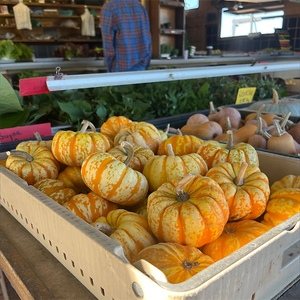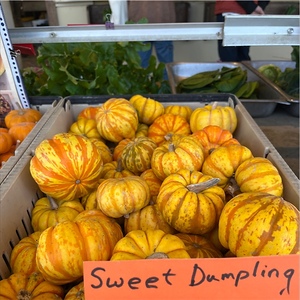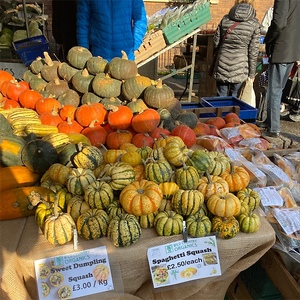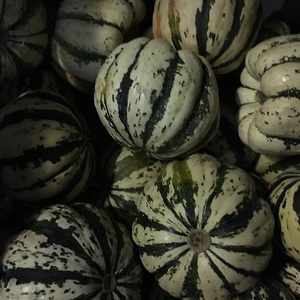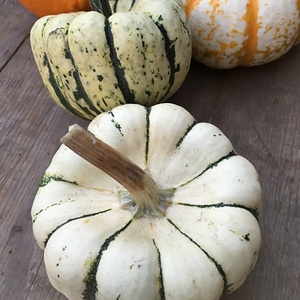


Dumpling Squash
Estimated Inventory, 20 lbs : 0
This item was last sold on : 01/24/24
Description/Taste
Dumpling squash is small in size, averaging 10-12 centimeters in diameter, and is round, slightly flattened and caved in at the top of the stem end. The thin skin has a creamy white base and depending upon maturity, is mottled with green, yellow, and orange vertical striping. There are also bold, scalloped, lobes outlining the squash, giving it a miniature pumpkin appearance. The light orange to gold flesh is firm and moist with a central, hollow cavity that contains stringy pulp and many flat, hard, cream-colored seeds. When cooked, Dumpling squash is smooth-textured, light, and tender with a sweet, mild flavor.
Seasons/Availability
Dumpling squash is available in the fall to mid-winter.
Current Facts
Dumpling squash, botanically classified as Cucurbita pepo, grows on short trailing vines and is a member of the Cucurbitaceae family along with gourds and pumpkins. Also known as Sweet Dumpling squash, Dumpling squash has a striking exterior similar in appearance to the delicata and sugar loaf and is known for its unique appearance and size. Dumpling squash was created as a compact variety that is an ideal individual serving size and can be easily grown in small spaces such as home gardens. It can be used in a wide variety of culinary applications and is also favored as a decorative bowl or container to serve sauces, soups, and dips during the fall season.
Nutritional Value
Dumpling squash contains vitamin A, B vitamins such as folate, riboflavin, and thiamin, beta-carotene, and is a good source of fiber.
Applications
Dumpling squash is best suited for cooked applications such as roasting, sautéing, baking, and steaming and it can be used in both sweet and savory preparations. Its lumpy exterior and small size make it difficult to peel and are most often cooked with their skin on. Similar to a potato and acorn squash, the skin of the Dumpling squash is edible once cooked, though often it is just discarded. Dumpling squash can be halved, cooked, and served as an ideal size for stuffing with meats, cheeses, grains, or other vegetables and it can be roasted and served as a stand-alone side dish. It can also be roasted or baked and added to warm, green salads or served alongside grilled meats. Dumpling squash pairs well with Italian parsley, sage, parsnip, beets, arugula, nutmeg, curry, nuts, strong cheeses, poultry, pears, apple, maple syrup, brown sugar, butter, and dried fruits. Dumpling squash will keep for a couple of months when stored in a cool, dark, and dry place.
Ethnic/Cultural Info
Dumpling squash was first introduced in the United States under the name vegetable gourd as a result of its appearance which resembled that of popular decorative gourds. The name, however, proved to be a poor marketing choice for the edible squash and it did not catch on as popular variety until it was renamed Sweet Dumpling squash. Today, Dumpling squashes are continuing to be improved with new hybrid varieties that have sweeter flesh, higher yields, and resistance to common squash diseases such as powdery mildew.
Geography/History
Dumpling squash was first developed in 1976 by Sakata Seed Corporation of Yokohama, Japan. At the time, it was a popular practice in Japanese squash breeding to take large American squash varieties and breed them to be smaller in size to market the squash as a home garden and home chef variety. Today Dumpling squash can be found at local farmers markets and specialty grocers in Asia, Australia, Europe, and the United States.
Recipe Ideas
Recipes that include Dumpling Squash. One



